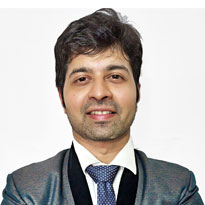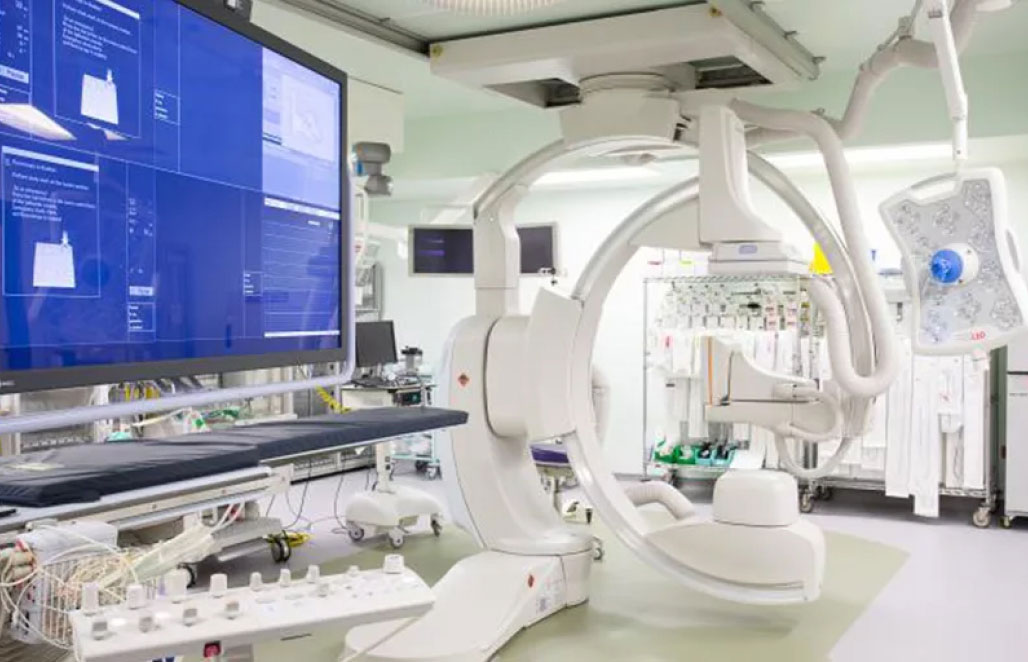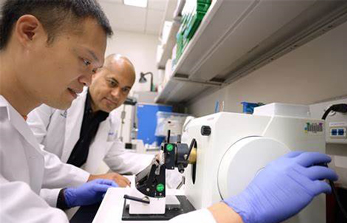A brain aneurysm is a ballooning in a blood vessel in the brain, usually caused by a weakness in the vessel wall.. It often looks like a berry and are also called berry aneurysms. A brain aneurysm can rupture, causing bleeding into the brain (haemorrhagic stroke). Most often a ruptured brain aneurysm occurs in the space between the brain and the thin tissues covering the brain. This type of haemorrhagic stroke is called a subarachnoid haemorrhage. Rarely unruptured aneurysm may cause symptoms due to pressure on adjacent structures and may get detected.
Ruptured aneurysm A sudden, severe headache is the key symptom of a ruptured aneurysm. This headache is often described as the "worst headache" ever experienced. Common signs and symptoms of a ruptured aneurysm include:
An unruptured brain aneurysm may produce no symptoms, particularly if it's small. However, a larger unruptured aneurysm may press on brain tissues and nerves, possibly causing:
Ruptured aneurysms are diagnosed with radiological imaging such as MR imaging and CT angiography. A diagnostic cerebral angiogram, which is a gold standard may be needed at times to delineate a small aneurysm or to better qualify its morphology and plan treatment.
Management of saccular aneurysms: Management of saccular aneurysm is with either surgery- clipping of the aneurysm or endovascular coiling of the aneurysm.
Surgery: Surgery involves creating a window on the skull, retracting the brain gently, identifying the aneurysm and placing one or multiple clips at the neck of aneurysm to occlude the aneurysm from the circulation.
Saccular aneurysms can be coiled as a method of treatment. However, we may need to use special devices like a protective intracranial balloon or stent while coiling in order to keep the coils within the aneurysm during and after the procedure
These are dilatation in the vessel wall either due to it being inflamed or due to atherosclerotic disease They are best managed by endovascular methods like flow diversion using special stents.
Smaller ones like blister aneurysms may be managed by wrapping a muscle patch over the wall to prevent risk of rupture in the future.
Tumours of the brain, its covering structures and spinal cord can be broadly divided into 2 groups: benign and malignant tumours. Primary brain tumours originate in the brain itself or in tissues close to it, such as in the brain-covering membranes (meninges), cranial nerves, pituitary gland. In contrast a metastatic or secondary tumour spreads to the brain from another part of the body. Primary brain tumours occur in around 250,000 people a year globally, making up less than 2% of cancers. The most common tumour of the brain is a metastatic tumour (figure metastasis) which has spread to the brain from a tumour location in some other part of the body; the commonest being lung cancer.The incidence of metastatic tumors are more prevalent than primary tumors by 4:1 Brain tumours in children can be low grade tumours like pilocytic astrocytomas or high grade developmental tumours like medulloblastomas. The most common primary brain tumors are:
Among children the common tumours are:
Primary brain tumours begin when normal cells acquire errors (mutations) in their DNA. Tumours are also known to occur in those with genetic syndromes like Neurofibromatosis 1 &2, tuberose sclerosis, Turcot syndrome, Von Hippel Lindau syndrome to name a few. Uncommon risk factors include exposure to vinyl chloride, Epstein–Barr virus, JC virus and ionizing radiation. Only a small percentage of brain tumours run in families. The symptoms depend on the location, size, and rate of growth of the tumour. Common symptoms include:
Evaluation begins with a complete clinical & neurological examination. For a high suspicion of a brain tumour, Contrast MRI is the investigation of choice.MRI can identify early or small tumours missed on CT. Different sequences can define changes in brain tissue and also characterise the tumour itself. MRI can also be used to guide biopsies or resections, as well as in follow-up imaging. Special sequences in MRI like functional MRI and MR tractography can help locate important areas within the brain and its relation to the tumour. Perfusion MRI may be helpful in differentiating radiation induced necrosis from a recurrent tumor. MR spectroscopy helps in indirectly characterizing the lesion and quantifying the grade of the tumour. CT scan is usually the first-line investigation in emergency presentations. It helps in fast detection of bleed, raised fluid collection within the skull(hydrocephalus) and involvement of bone by tumour. Hormonal evaluation: Used in pre-operative preparation of pituitary adenomas. A PET scan would be helpful in the work-up for a metastatic brain tumour in localising the primary and other sites of tumour. Few other specific investigations may be required depending on the type of tumor suspected like Pure Tone Audiometry, Visual field Charting, CSF analysis for tumor markers etc
The choice of treatment depends on:
The 3 modalities for management of brain tumours are surgery, radiation therapy and chemotherapy. Each of these modalities can be used in conjunction with the other based on the grade of tumour, the extent of resection and tumour type.
A spinal tumour is a growth that develops within or adjacent the spinal cord.. Tumours that arise from the bones of the spine are called vertebral tumours they may be primary or vertebral metastasis from other body part cancers. A spinal tumor may arise within the spinal cord- most common tumours are astrocytomas or ependymomas (figure spinal intramedullary). Tumours may also develop from the supporting cells which line the spinal cord or spinal nerves. Most common tumours are schwannomas, meningiomas and neurofibromas. Though they lie outside the spinal cord, they can compress the spinal cord and produce symptoms.
Common symptoms of spinal tumours are: back pain, difficulty in using hands or walking, altered sensation in hand or legs, bowel and bladder disturbances.Diagnosis: MRI is the modality of choice for evaluation of spinal tumours. It provides information on the location of tumour, its relation to the spinal cord and nerves.
Surgery for spinal tumours provides tissue for histopathological examination. Adjuvant therapy in the form of radiation for tumours like astrocytomas and ependymomas is based on the grade of tumorand extent of surgical resection. For tumours like meningiomas and neurofibromas/schwannomas complete excision forms the mainstay of treatment
Degenerative spine/disc disease (DDD) involves degeneration of the discs, ligaments, and joints of your spine.. Age related changes in the spine occur in all, however it becomes a concern when it affects the quality of life. It is the most common of all spine disorders.
DDD can occur anywhere in your spine, but it is most common in the cervical spine (neck) and the lumbar spine (lower back). It can cause pain, numbness, or weakness in your arms or legs. Risk factors for degenerative spine/disc disease include increased age, obesity, lack of exercise, trauma, family history, osteoporosis, and smoking.
To diagnose degenerative spine/disc disease, doctors conduct a thorough physical examination. We may also order a diagnostic imaging test such as a magnetic resonance imaging, X-ray, or computed tomography scan. Our goal is to determine how quickly we need to react. Weakness and incontinence is usually a sign of urgency while we can treat pain and numbness with more conservative measures.
While some spinal degeneration occurs with normal aging, it does not always cause symptoms. The best way to prevent symptoms is to maintain a healthy, active lifestyle, perform weight-bearing exercises to maintain strong bones, and avoid smoking.
Usually, pain medications, adequate rest followed by physical therapy can relieve your symptoms.. Sometimes surgery is necessary. Depending on your individual situation and health, we use either a minimally invasive approach or a more traditional ‘open’ procedure. We perform these types of surgery:
Acute discs typically get better with rest. The only absolute indication for surgery (where surgery must be done or the damage is possibly irreversible) is if the disc is so large that it suddenly causes bowel or bladder problems. In that case, the surgery should be done right away to prevent permanent damage to those nerves. If the disc is in the neck and the legs are suddenly affected, some surgeons would consider an operation necessary right away. Some surgeons may also consider surgery if the symptoms of weakness in the extremities are progressing at a rapid rate. In a vast majority of cases, immediate surgery is not indicated. Because up to 98 percent of disc problems get better without surgery, it is not needed if the symptoms can be controlled. Tingling and numbness get better in most cases, and weakness in the muscles may take longer to recover. Some patients have recurrent bouts of back pain with or without nerve involvement. Sometimes these happen frequently and keep the person out of work, out of their sport or generally restricted from their activities If these symptoms keep recurring and do not get better with conservative treatment , surgery may be required.
The indications for surgery for arthritis of the spine are similar to those for a disc problem in the spine. If someone has pain that is easily controlled with rest and medication only every now and then, surgery is not indicated. If the pain and nerve symptoms occur frequently, are severe and limit your activity or are not controlled easily with rest and medication and are generally ruining your life, then surgery is a consideration. Rarely the spine with arthritis gets so bad that the bones and spurs begin to constrict the nerves and the spinal cord. This gradual squeezing of the spinal cord is called stenosis and can happen very slowly. In some cases, surgery is necessary to stop or slow down the process and is typically performed only when the symptoms get severe. The surgery for arthritis of the spine depends on exactly what is being pinched and where the arthritis is located. Sometimes the surgery is just to remove the spurs that are compressing the nerves, and sometimes the vertebrae are fused together to prevent the irritation that occurs when the two bones rub against each other when the spine moves. The results of surgery and prognosis after surgery should be discussed with your surgeon.
Epilepsy surgery is a procedure that removes or alters an area of your brain where seizures originate.
Epilepsy surgery is most effective when seizures always originate in a single location in the brain. Epilepsy surgery is not the first line of treatment but is considered when at least two anti-seizure medications have failed to control seizures.
A number of pre-surgical assessments are necessary to determine whether you're eligible for epilepsy surgery and how the procedure is performed.
Epilepsy surgery may be an option when medications do not control seizures, a condition known as medically refractory epilepsy or drug-resistant epilepsy. The goal of epilepsy surgery is to eliminate seizures or limit their severity and frequency with or without the use of medications.
Poorly controlled epilepsy can result in a number of complications and health risks, including the following:
Epileptic seizures result from abnormal activity of certain brain cells (neurons). The type of surgery depends largely on the location of the neurons that trigger the seizure and the age of the patient. Types of surgery include the following:
If you're a possible candidate for epilepsy surgery, you will work with our medical team at a specialized epilepsy unit. Our team will conduct several tests to determine your eligibility for surgery, identify the appropriate surgical site and understand in detail how that particular region of your brain functions. Some of these tests are performed as outpatient procedures, while others require a hospital stay.
The following procedures are standard tests used to identify the source of abnormal brain activity.
To avoid infection, your hair will need to be clipped short or shaved over the section of your skull that will be removed during the operation. You will have a small flexible tube placed within a vein (intravenous access) to deliver fluids, anesthetic drugs or other medications during the surgery.
Your heart rate, blood pressure and oxygen levels will be monitored throughout the surgery. An EEG monitor also may be recording your brain waves during the operation to better localize the part of your brain where your seizures start.
Epilepsy surgery is usually performed during general anesthesia, and you'll be unconscious during the procedure. In rare circumstances, your surgeon may awaken you during part of the operation to help the team determine which parts of your brain control language and movement. In such cases, you would receive medication to control pain.
The surgeon creates a relatively small window in the skull, depending on the type of surgery. After surgery the window of bone is replaced and fastened to the remaining skull for healing.
You'll be in a special recovery area to be monitored carefully as you awaken after the anesthesia. You may need to spend the first night after surgery in an intensive care unit. The total hospital stay for most epilepsy surgeries is usually about three or four days.
When you awaken, your head will be swollen and painful. Most people need narcotics for the pain for at least the first few days. An ice pack on your head also may help. Most postoperative swelling and pain resolve within several weeks.
You'll probably not be able to return to work or school for approximately one to three months. You should rest and relax the first few weeks after epilepsy surgery and then gradually increase your activity level.
It's unlikely that you would need intensive rehabilitation as long as the surgery was completed without complications such as a stroke or loss of speech.
Neurotrauma is an injury to brain or spinal cord or nerves caused by any means of trauma which may include Road Traffic Accidents, Fall from height, Assault etc. It includes concussions, traumatic brain injuries (TBI), skull fractures, spinal column fractures, and spinal cord injuries (SCI).
Head trauma is any injury to your head, from a minor bump on the skull to serious brain trauma. It usually comes from getting hit on the head or skull and can happen if you fall, if there’s a sudden acceleration-deceleration (as in a motor vehicle accident or child abuse) or assault, or if you’re hit by a projectile. Head trauma can cause your brain cells to malfunction. The extent of the injury and how long it lasts depends on how badly you were hurt.
We treat the following types of head trauma:
You can also have an injury to your spinal column (cervical, thoracic, or lumbosacral spine) or spinal cord due to a fall, car accident, collisions with a moving object (such as a car), or an assault. As with head injuries, there are many types of spine trauma, which vary in severity. Depending on what happened, you might become weak or paralyzed. We routinely treat these types of spine trauma:
Neurotrauma can occur by itself, or together with other bodily injury. Most people who experience serious injury to their head or spine come to the hospital through the emergency room (ER) and do not schedule appointments or pick their surgeons. When you come to our ER, we immediately evaluate you for head or spine injury, often utilizing a brain scan to give us a clear view of your injuries. Typically, we use a computed tomography (called CT or CAT) scan of the head or spine or we may use magnetic resonance imaging (MRI) instead.
If after you leave the hospital, you have problems with social situations or easy tasks, you should immediately return to First Neuro for further examination.
Imaging scans are not always enough to know exactly what is happening in your brain or spine. To diagnose a TBI, we conduct:
The way we treat head and spine injuries depends on several factors, including the type of injury and how serious it is. Mild injuries may just require careful observation. More severe trauma may call for surgery. Certain types of injuries need surgery, even if they are not very severe.
At First Neuro, we also offer neuropsychological therapy, speech therapy, physical therapy, occupational therapy, and rehabilitation medicine, depending on your needs.
We perform the following surgical procedures:
Most people with mild traumatic injuries to the head or spine end up doing well and many recover completely. Sometimes, though, even after a mild injury like a concussion, you may have symptoms that don’t go away. If this happens, we will continue to work with you.
If you have severe injury, you may require long-term rehabilitation services. You can avail these services in First Neuro Rehabilitation Centre.
“ No Head Injury is too trivial to be ignored”
Any serious illness that befalls a child causes enormous emotional and physical strain, both for the child and the family. Neurosurgical problems in the paediatric age group are often difficult and complex. At First Neuro, our Neurosurgery unit offers comprehensive care for the full range of brain, spine, peripheral nerve, and craniofacial disorders in children and adolescents. Due to our team’s clinical expertise in brain tumours, epilepsy, Chiari malformations, tethered cord syndrome, craniosynostosis, and hydrocephalus, integration with Neurosurgeons is paramount. Furthermore, with professional support from an array of family-centred specialists like paediatric therapists, and our on-site child education and recreation therapy offerings. Innovative work in new, minimally-invasive neurosurgery and imaging techniques, supported by cutting-edge technology and pioneering laboratory research gives our Program an advantage in efficiency of diagnosis and in developing lower risk surgical treatments.
We work closely with our paediatricians and surgeons from other affiliated medical and surgical services such as Paediatric Neurology, Paediatric Haematology and Oncology, Paediatric General Surgery, Plastic, Reconstructive & Aesthetic Surgery, Ophthalmology, Orthopaedic Surgery, Obstetrics & Gynaecology and Diagnostic Imaging (Neuroradiology) to provide care for our young patients.
Paediatric neurosurgeons diagnose, treat, and manage children’s nervous system problems and head and spinal deformities including the following:
The Unit of Neurosurgery provides expert surgical treatment for children with:
If your child experiences a traumatic brain or spine injury, you can rely on First Neuro’s Paediatric Neurosurgery for expert evaluation and treatment. Our approach involves a coordinated team of paediatric specialists who carefully assess your child, form a diagnosis, and develop and implement a treatment plan tailored to your child’s needs.
Your child’s injury will be diagnosed by a neurological exam, blood test, X-ray, MRI, CT scan, EEG or a combination of these tests. Depending on the severity of his or her injury, your child’s treatment may include:
If surgery is the best treatment option for your child, you can be assured that First Neuro’s neurosurgeons use state-of-the-art imaging and surgical techniques. These techniques let neurosurgeons precisely plan and perform surgery and use the safest approach possible.
For example, in some situations, your surgeon may be able to address your child’s injury through a neuroendoscopy, a minimally invasive procedure that lets the surgeon repair the injury through a small hole in the skull or through the mouth or the nose using small cameras and instruments.
After surgery, a team of doctors and nurses who are specially trained in paediatric critical care will assist with your child's recovery. Before your child is released from the hospital, your team will provide you with detailed instructions about follow-up care and how to care for your child at home./p>

Consultant Neuro Surgeon
View More >>




